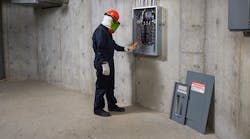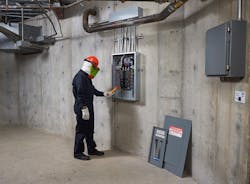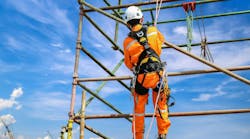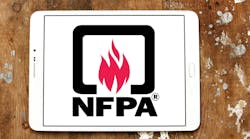This article was written by James White of Shermco Industries for Fluke Corp.
The 2018 edition of NFPA 70E, Standard for Electrical Safety in the Workplace, includes training requirements for electrical workers, both qualified and unqualified. OSHA regulations also include training requirements. The question is: When putting together a training program, which of these standards and requirements does an electrical manager need to follow and for which employees?
OSHA, CSA Z462, Workplace Electrical Safety, and NFPA 70E do not look at a worker’s job title. When determining what level of training is required, these regulations consider the hazards a worker may be exposed to. Any worker exposed to electrical hazards is considered a qualified person who needs higher-level training. This may include many workers who do not consider themselves as electrically qualified, such as HVAC technicians, multi-craft workers, welders, and general maintenance personnel. Note that this would normally mean any exposed energized conductor or circuit part above 50V, but it can also mean abnormal operations, such as inserting or removing (racking) circuit breakers or motor control center (MCC) buckets. There can be an increased arc flash risk, even if the doors are closed. Since the electrical conductors and circuit parts are guarded, there would be no shock risk in this situation.
The purpose of electrical safety training is not only to meet the letter of the law, but also to ensure employees understand what is required of management and the worker when it comes to electrical safety. When employees perform tasks that could injure or kill them, they are required to have a level of training that ensures they can recognize and avoid that hazard and take steps to mitigate the risk.
Building context
One method to determine OSHA’s intent is to read their Letters of Interpretation (LOI). These are OSHA’s responses to letters that people and companies have written, asking OSHA to provide more detailed explanations to specific questions and scenarios. They can be found on OSHA’s website under “standards.”
Each LOI relates back to a particular section of the standard. One LOI dated November 22, 1994, concerns initial training for HAZWOPER (OSHA Hazardous Waste Operations and Emergency Response Standard). The risks associated with HAZWOPER training are similar to those posed by working when exposed to electrical hazards in that both sets of workers are exposed to hazards that could injure or kill. The OSHA LOI response sounds like a response to an electrical safety question. This particular LOI answers a question on computer, video, or web-based training. OSHA states in the LOI:
“Our position on this matter is essentially the same as our policy on the use of training videos, since the two approaches have similar shortcomings. OSHA urges employers to be wary of relying solely on generic, “packaged” training programs in meeting their training requirements. For example, training under HAZWOPER includes site-specific elements and should also, to some degree, be tailored to workers’ assigned duties.
“Safety and health training involves the presentation of technical material to audiences that typically have not had formal education in technical or scientific disciplines, such as in areas of chemistry or physiology. In an effective training program, it is critical that trainees are given the opportunity to ask questions where material is unfamiliar to them. In a computer-based program, this requirement may be providing a telephone hotline so that trainees will have direct access to a qualified trainer.
“Equally important is the use of hands-on training and exercises to provide trainees with an opportunity to become familiar with equipment and safe practices in a non-hazardous setting. Many industrial operations — hazardous waste operations, in particular — can involve many complex and hazardous tasks. It is imperative that employees be able to perform such tasks safely. Traditional, hands-on training is the preferred method to ensure that workers are prepared to safely perform these tasks. The purpose of hands-on training, for example, in the donning and doffing of personal protective equipment, is two-fold: first, to ensure that workers have an opportunity to learn by experience; and second, to assess whether workers have mastered the necessary skills. It is unlikely that sole reliance on a computer-based training program is likely to achieve these objectives.
“Thus, OSHA believes that computer-based training programs can be used as part of an effective safety and health training program to satisfy OSHA training requirements, provided that the program is supplemented by the opportunity for trainees to ask questions of a qualified trainer, and provides trainees with sufficient hands-on experience.”
This LOI highlights four important requirements for initial safe work practices training:
1. Training must be tailored to be site-specific and the worker’s duties.
2. Initial training must be interactive and effective.
3. Trainees must have an opportunity to have specific questions answered immediately, not after some period of time.
4. Training must be hands-on and have a demonstration of skills.
5. OSHA prefers instructor-led, hands-on training — especially for initial safety training.
Identifying who is “qualified”
The following is OSHA’s definition of a qualified person (29CFR1910.399):
“One who has received training in and has demonstrated skills and knowledge in the construction and operation of electric equipment and installations and the hazards involved.”
Qualified persons must have:
• Skills and knowledge of the construction of the equipment they are about to work on or operate, as well as how the manufacturer recommends that equipment be operated.
• Skills and techniques to understand how the electrical system operates and the hazards associated with that equipment and system.
“Installations” refer to the type and configuration of the electrical system; main-tie-main, double-ended substation, breaker-and-a-half, ring bus, radial, etc. Each of these types of electrical systems features unique hazards workers must understand. A qualified person must receive training in and demonstrate skills and knowledge in all the above.
For qualified workers (those who are exposed or may be exposed to electrical hazards), OSHA requires the following from 29CFR1910.332(b)(3) and 1910.333:
“Qualified persons (i.e., those permitted to work on or near exposed energized parts) shall, at a minimum, be trained in and familiar with the following:”
1. Absence of voltage testing 1910.332(b)(3)(i) — “The skills and techniques necessary to distinguish exposed live parts from other parts of electric equipment.”
Interpretation: Qualified persons must be able to demonstrate the skills and techniques for performing absence of voltage testing.
2. Nominal voltage 1910.332(b)(3)(ii) — “The skills and techniques necessary to determine the nominal voltage of exposed live parts, and ….”
Interpretation: The qualified person must demonstrate the ability and knowledge to use single-line diagrams, equipment nameplates or other sources to determine what the nominal system voltage (that is, the phase-to-phase voltage) of exposed live parts, choose the appropriate test instrument and understand its limitations.
3. Approach distances 1910.332(b)(3)(iii) — “…. the clearance distances specified in 1910.333(c) and the corresponding voltages to which the qualified person will be exposed.”
Interpretation: The qualified person must understand what the shock and arc flash boundaries are and how to apply them to protect others. OSHA specifically calls out the approach boundary for shock hazards, but now that the arc flash boundary can be determined, it is included as well.
4. Safe work zone 1910.333(c)(2) — “Work on energized equipment. Only qualified persons may work on electric circuit parts or equipment that have not been de-energized under the procedures of paragraph (b) of this section. Such persons shall be capable of working safely on energized circuits and shall be familiar with the proper use of special precautionary techniques, personal protective equipment, insulating and shielding materials, and insulated tools.”
Interpretation: a) Proper use of special precautionary techniques refers to being able to set up a safe work zone around exposed energized conductors or circuit parts. The barrier or barricade would be erected at either the limited approach boundary or the arc flash boundary, whichever is farthest from the exposed energized conductors or circuit parts.
b) Use of personal protective equipment (PPE). This would include how to choose the PPE that would provide adequate protection, how to inspect it, how to wear it or use it, how to store it, how to care for it, what its testing requirements are (if any), and its limitations of use.
c) Use of insulated tools covers much of the same requirements for choosing, inspecting, storing, and limitations of use as for PPE. This is no small thing, and there must be some methodology of documenting that the qualified person demonstrated these skills successfully.
To perform the above, a qualified person must be able to interpret arc flash warning labels if a company has had an incident energy analysis performed at its site. Arc flash warning labels are covered in NFPA 70E Sec. 130.5(H). Arc flash warning labels also provide guidance on selecting the PPE required. If no arc flash warning labels are present, qualified persons must be able to select PPE based on the tables in NFPA 70E and be able to determine when the tables cannot be used. This could be because the available fault current is above that given in the tables, or if the operating time of the overcurrent protective device is too long, or if the working distance is not sufficient. Any of these conditions would require an incident energy analysis to be performed.
Differences by standard
NFPA 70E and Canada’s Z462 Clause 4.1.6.4 have almost identical requirements to OSHA, but also add the following:
NFPA 70E Sec. 110.2 (A)(1)(c)(4), “Decision-making process necessary to be able to do the following:
1. Perform the job safety planning
2. Identify electrical hazards
3. Assess the associated risk
4. Select the appropriate risk control methods from the hierarchy of controls identified in 110.1(H), including personal protective equipment.”
The 2018 edition of NFPA 70E now includes requirements to assess the potential for human error as part of the risk assessment procedure. This would include what mistakes might be made, the effects such a mistake might create, and how to prevent such errors from occurring. This can be difficult to do, especially with the scope of the section. The 70E committee does not expect technicians or supervisors to be able to perform such an assessment flawlessly, but to make their best effort to account for such errors.
Another new requirement in Sec. 110.1 is to develop a job safety plan. This was thrown in together with the job briefing requirement of previous editions of NFPA 70E, but was separated out to provide more emphasis on planning the job [110.1(I)]. Once the job planning is completed and documented, that job safety plan is communicated to others involved or affected using a job briefing. A job safety plan can be a job hazard assessment (JHA), job safety assessment (JSA), or however it may be referred to in your organization. These changes need to be a part of the initial training or retraining required by NFPA 70E in Sec. 110.2.
Be aware that Z462 is behind NFPA 70E by a cycle, so those requirements are, at the time of the writing of this article, not exactly the same. Typically, Z462 adopts what NFPA 70E has added in the latest edition, but sometimes not. The reader must ensure they understand the requirements of the province they reside or work in, as each Canadian province has different requirements. Z462 is the first national safety standard adopted by CSA. This article will use the wording in the 2018 edition of NFPA 70E as its basis.
Training
Where OSHA is “non-prescriptive,” that is, they won’t typically require anything specific, NFPA 70E and Z462 are prescriptive. NFPA 70E Sec. 110.2(A) and Z462 Clause 4.1.6.1 state:
“(A) Safety Training. The training requirements contained in this section shall apply to employees exposed to an electrical hazard when the risk associated with that hazard is not reduced to a safe level by the applicable electrical installation requirements. Such employees shall be trained to understand the specific hazards associated with electrical energy. They shall be trained in safety-related work practices and procedural requirements, as necessary, to provide protection from the electrical hazards associated with their respective job or task assignments. Employees shall be trained to identify and understand the relationship between electrical hazards and possible injury.”
Note that even NFPA 70E and Z462 can be somewhat vague. No one can foresee all circumstances and conditions the worker may have to perform their task in, so it is impossible to provide a step-by-step training requirement. The employer must assess the hazards and the risk for each task at their company’s work site and determine what training is required to protect workers.
OSHA and NFPA 70E require the training of anyone who may be exposed to electrical hazards. The training must include electrical hazard awareness, procedures and requirements needed to avoid the hazards, and understanding of the relationship between electrical hazards and the injuries that may be caused by those hazards. The employer must ensure training is site-specific and covers actual hazards workers that may encounter.
Retraining
NFPA 70E does not call out the need for refresher training. There is a requirement for retraining every three years. Refresher training can be conducted as the company believes it is necessary. Most companies use an annual requirement for refresher training to remind qualified persons of the risk involved in electrical work.
Retraining is more involved, but does not have to repeat the initial training a qualified person received. Additional training or retraining is required every three years or:
1. If the supervision or annual inspections indicate the employee is not complying with the safety-related work practices.
2. If new technologies, new types of equipment or changes in procedures necessitate the use of safety-related work practices different from those the employee would normally use.
3. If the employee has not performed a task in more than a year, then they would be required to review the steps to perform that task safely.
4. If the employee needs to review safety-related work practices not normally used during their regular job duties.
5. If the employee’s job duties change.
Retraining is specifically required to cover any changes in safety-related work practices, including changes to NFPA 70E, OSHA regulations or company work practices or policies.
Emergency response training. NFPA 70E and Z462 require emergency response training. Using the wording in NFPA 70E 110.2(C):
“(1) Contact Release. Employees exposed to shock hazards shall be trained in methods of safe release of victims from contact with exposed energized electrical conductors or circuit parts. Refresher training shall occur annually.
“(2) First Aid, Emergency Response, and Resuscitation.
“(a) Employees responsible for responding to medical emergencies shall be trained in first aid and emergency procedures.
“(b) Employees responsible for responding to medical emergencies shall be trained in cardiopulmonary resuscitation (CPR). Refresher training shall occur annually.
“(c) Employees responsible for responding to medical emergencies shall be trained in the use of an automated external defibrillator (AED) if an employer’s emergency response plan includes the use of this device.”
“(d) Training shall occur at a frequency that satisfies the requirements of the certifying body.”
The changes to the frequency of emergency response training were made because NFPA 70E should provide minimum requirements, not best safe work practice requirements. Be aware that the minimum requirements from the American Heart Association and other such organizations are for the general public, not for jobs that involve electrical risk.
The above section still requires annual training in emergency release of shock victims. Such training is required for both first responders and for employees exposed to the shock hazard. This would include all qualified persons.
Additional training
Other training requirements in NFPA 70E/Z462 include:
• Persons undergoing training who can then demonstrate the ability to perform specific tasks safely can be considered qualified for that task. However, that person may still be unqualified in regard to other tasks.
• Tasks performed less often than once per year require retraining on that task before they can perform that task again. NFPA 70E changed the wording of this subsection for 2018 to a requirement to “review” tasks that have not been performed in more than a year. Best safe work practice would still be to provide retraining, which can be on-the-job (OJT). Be careful to document such OJT, as OSHA inspects training records in the event of an accident.
• Qualified persons must be trained to select the appropriate test instrument. That qualified person must also demonstrate how to safely use the test instrument to determine the absence of voltage, interpret the indications of the test instrument, be able to inspect the test instrument to ensure it is safe to use and understand the limitations of the test instrument being used.
• Employers must conduct regular audits to ensure their employees are following the safety-related work practices required by the standards as well as their company.
• Unqualified persons must also have training. They must be trained on how to recognize and avoid electrical hazards they may encounter. If they interact with equipment, such as operating electrical equipment — especially circuit breakers, fused switches and MCCs — then they must be trained to understand how the equipment functions and operates, and the hazards and risk that may be present when operating the equipment. If PPE is required, unqualified workers must receive training on the selection, inspection, use, care and limitations of that equipment.
• Retraining (not refresher training) must be conducted at least every three years. Retraining must include changes made to applicable OSHA regulations, NFPA 70E/Z462, company work practices, procedures and policies changes being made as a result of such changes.
Lockout/tagout training
In addition, NFPA 70E and Z462 have requirements for lockout/tagout (LOTO) training in Art. 120 / Clause 4.2.2.2.2. LOTO training requirements include:
• All persons exposed or affected by a LOTO must be trained to understand the LOTO procedure and their responsibilities in its execution.
• If the worker is new or recently assigned, they require training to understand the LOTO procedure and their responsibilities.
• Retraining is required whenever the procedure(s) are revised or at least every three years.
• LOTO training must be documented.
Lockout/tagout training requirements have been moved to Sec. 110.2 so that all training requirements are located in one section. This should make finding them easier. The actual training requirements for lockout/tagout training remain unchanged from the 2015 edition.
Summary
NFPA is advocating an integrated approach to risk analysis, PPE selection, and safe work practices, with training as the cornerstone. It can be tempting to think of regulation-driven training as an overhead expenditure, but, done right, good training improves the safety and efficiency of your technical workforce and often reduces long-term expenses.
White is director of training for Shermco Industries in Irving, Texas. He can be reached at [email protected].
Sidebar 1: What to Look for in a Training Provider
Most employers face the need to bring in a safety training specialist for part (or all) of the training requirements. The challenge can be differentiating between training options, since not all private training programs meet the requirements discussed above. Here’s a list of helpful guidelines to keep in mind when seeking out a qualified training provider:
• By these standards, initial electrical safety training cannot be done in one day.
• Initial electrical safety training must have hands-on labs with a documented demonstration of skills. Some training companies will not perform documented lab sessions and advise the customer to “do it later.” Later doesn’t come.
• Look at the instructor’s qualifications, and check references. Being an engineer or ex-utility worker does not on its own qualify someone to present electrical safety training.
• Membership on NFPA 70E Committee, Z462 Committee, NEC Code-Making Panels, etc., indicates a better understanding of those documents.
• Don’t go low-bid. There’s usually a reason training is inexpensive.
• Don’t be a “box checker” or someone who just wants to “get it over with.” People’s lives may depend on the safety training they receive.
Sidebar 2: Summary of OSHA, NFPA, and CSA Electrical Safety Training Requirements
• Training is required for qualified and unqualified persons.
• A qualified person is anyone exposed to or potentially exposed to electrical hazards.
• Training is required to establish an understanding of their and their employer’s responsibilities for electrical safety.
• Training must be such that attendees are able to recognize and avoid electrical hazards.
• Initial training must have a method to immediately respond to questions from the attendees and have a hands-on portion to establish proficiency.
• Resist the urge to perform “check-the-box” training. It may save you money in the short term, but if someone is injured you may have to defend your choice in court.
• Trainees may not have a formal education in areas relating to electrical safety.
• Training is to be effective, site-specific and cover the hazards at that location.
• Computer-based and video training can be used to augment instructor-led training, but cannot replace it.
• Qualified persons must have training in and demonstrate skills and knowledge of electrical equipment and power systems. Such training must cover:
— Basic construction of the equipment and power system.
— The manufacturer’s recommended operating procedures, including the use of any specialized tools or attachments.
— The hazards associated with operating the equipment or power system.
• Qualified person training must receive training in:
— Skills and techniques to test for the presence and absence of voltage.
— Skills and techniques to determine nominal (phase-to-phase) voltage of the electrical power system.
— Safe approach distances for electrical shock and arc flash.
— Performing safety job planning.
— Assessing the risk associated with a specific job task.
— Selecting the appropriate methods from a hierarchy of controls, including PPE.
— Safety-related work practices and procedures to perform the job task safely.
— How to identify and understand the relationship between electrical hazards and injury.
— How to select the correct test instrument, how to inspect it, how to safely use it, what it’s limitations of use are, and interpret the indications.
• Annual training is required for contact release.
• First aid, AED and CPR training is required at intervals that satisfy the requirements of the certifying organization.
• Training is required for the use of AEDs, if there are AEDs on site.
• Workers can be qualified to perform specific tasks, if they receive training in and demonstrate proficiency at that task while being supervised by a qualified person.
• Tasks performed less often than once per year require retraining before that task can be performed again.
• Supervisors are required to perform inspections and audits, at least annually, to determine if their employees are following company procedures and NFPA 70E/Z462.
• Even unqualified persons must have training in:
— How to recognize and avoid electrical hazards they may encounter.
— How to operate electrical equipment.
— What the hazards are associated with the use of such equipment.
— What PPE may be required and when to use it.
— How to inspect, maintain and store electrical PPE.
— What the limitations are of electrical PPE.




